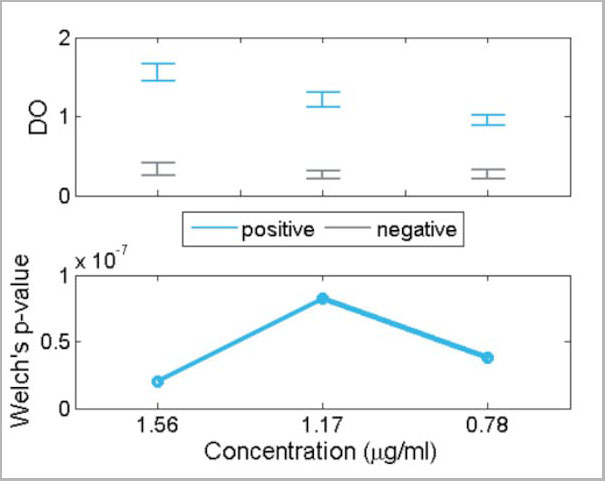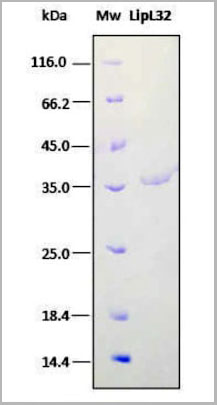Suggested Titer by ELISA: Up to 1:1,487, which corresponds to 0.78 ug/ml of protein concentration in plates for IgM detection.
Possible Applications: WB, DB, Indirect ELISA, positive control in direct ELISA, CLIA, lateral-flow.
Where this product has not been tested for use in a particular technique, this does not necessarily exclude its use in such procedures. Suggested working dilutions are given as a guide only. It is recommended that the user titrates.
Concentration Note: *The measurement of the protein concentration has been performed with the theoretical extinction coefficient of the recombinant protein obtained from Gill and vonHippel, 1989. It is recommended that the users carry out their absorbance determinations to avoid equipment variabilities regarding final concentration, mainly in reproducibility analysis.
DO280 = 1.08
A0.1 % (=1 g/l) = 0.923
Application Data
(In this plot, the optical density at 450/620 nm for positive (blue) and negative (gray) IgM sera are compared for each concentration of the recombinant antigen. An appropriate statistical test of significance for the comparison of means between both groups, the Welch's test, is employed. Eligible concentrations for the use of the antigen should present statistically significant differences between positive and negative sera. This happens when the intervals at the top do not overlap and, equivalently, when the p-value at the bottom is below 0.05. In the present figure, all p-values are below 0.05 and thus the intervals do not overlap. Therefore, any of the showed concentrations can be used to distinguish between positive and negative sera.)
SDS-PAGE
(SDS-PAGE analysis (12%) of 1 ul of recombinant LipL32. Purity is >95% as determined by gel electrophoresis.)
Gill SC, von Hippel PH. Calculation of protein extinctioncoefficients from amino acid sequence data. AnalBiochem. 1989 Nov 1;182(2):319-26.
NCBI and Uniprot Product Information
Similar Products
Product Notes
The lipl32 (Catalog #AAA14238) is a Recombinant Protein produced from Escherichia Coli. and is intended for research purposes only. The product is available for immediate purchase. AAA Biotech's lipl32 can be used in a range of immunoassay formats including, but not limited to, ELISA (EIA). Titration Curve By An ELISA Assay: The titer has been suggested in reference to an "in-house" ELISA kit performed over the first lot obtained. Each end user should carry out their own titration for their particular application. Suggested Titer by ELISA: Up to 1:1,487, which corresponds to 0.78 ug/ml of protein concentration in plates for IgM detection. Possible Applications: WB, DB, Indirect ELISA, positive control in direct ELISA, CLIA, lateral-flow. Where this product has not been tested for use in a particular technique, this does not necessarily exclude its use in such procedures. Suggested working dilutions are given as a guide only. It is recommended that the user titrates. Concentration Note: *The measurement of the protein concentration has been performed with the theoretical extinction coefficient of the recombinant protein obtained from Gill and vonHippel, 1989. It is recommended that the users carry out their absorbance determinations to avoid equipment variabilities regarding final concentration, mainly in reproducibility analysis. Researchers should empirically determine the suitability of the lipl32 for an application not listed in the data sheet. Researchers commonly develop new applications and it is an integral, important part of the investigative research process. It is sometimes possible for the material contained within the vial of "lipl32, Recombinant Protein" to become dispersed throughout the inside of the vial, particularly around the seal of said vial, during shipment and storage. We always suggest centrifuging these vials to consolidate all of the liquid away from the lid and to the bottom of the vial prior to opening. Please be advised that certain products may require dry ice for shipping and that, if this is the case, an additional dry ice fee may also be required.Precautions
All products in the AAA Biotech catalog are strictly for research-use only, and are absolutely not suitable for use in any sort of medical, therapeutic, prophylactic, in-vivo, or diagnostic capacity. By purchasing a product from AAA Biotech, you are explicitly certifying that said products will be properly tested and used in line with industry standard. AAA Biotech and its authorized distribution partners reserve the right to refuse to fulfill any order if we have any indication that a purchaser may be intending to use a product outside of our accepted criteria.Disclaimer
Though we do strive to guarantee the information represented in this datasheet, AAA Biotech cannot be held responsible for any oversights or imprecisions. AAA Biotech reserves the right to adjust any aspect of this datasheet at any time and without notice. It is the responsibility of the customer to inform AAA Biotech of any product performance issues observed or experienced within 30 days of receipt of said product. To see additional details on this or any of our other policies, please see our Terms & Conditions page.Item has been added to Shopping Cart
If you are ready to order, navigate to Shopping Cart and get ready to checkout.





